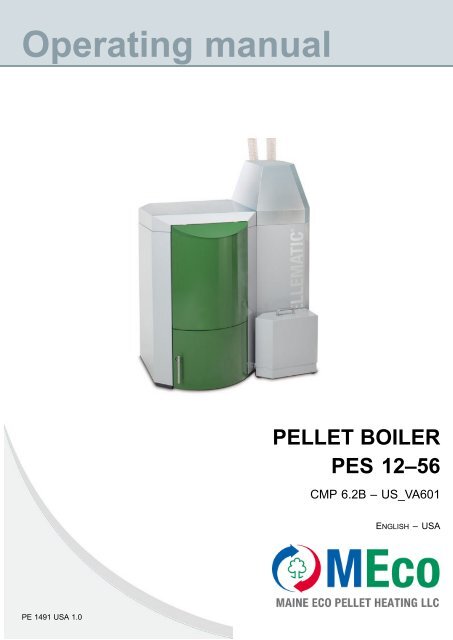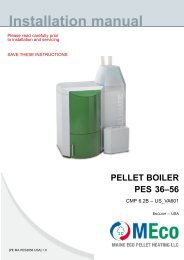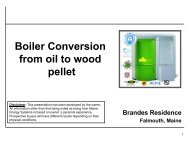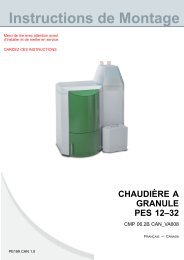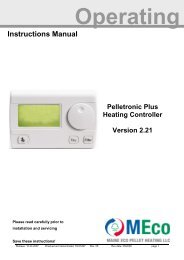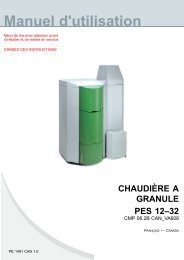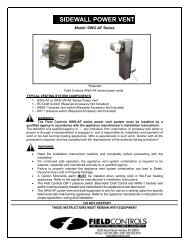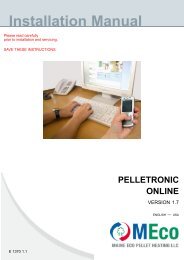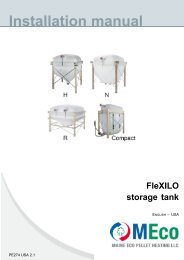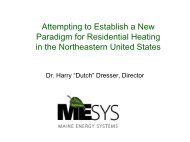Operating manual - Maine Energy Systems
Operating manual - Maine Energy Systems
Operating manual - Maine Energy Systems
You also want an ePaper? Increase the reach of your titles
YUMPU automatically turns print PDFs into web optimized ePapers that Google loves.
<strong>Operating</strong> <strong>manual</strong><br />
PELLET BOILER<br />
PES 12–56<br />
CMP 6.2B – US_VA601<br />
ENGLISH – USA<br />
PE 1491 USA 1.0
Title: <strong>Operating</strong> <strong>manual</strong> Pellet Boiler PES 12-56<br />
Article number: PE 1491 USA 1.0<br />
Version: 01.01<br />
Version valid from: 10/2009<br />
approved:<br />
Humberger Stephan<br />
Author:<br />
MAINE ECO PELLET HEATING LLC<br />
USA- Headquarter<br />
8 Airport Road – P.O. Box 547Bethel<br />
<strong>Maine</strong> 04217<br />
e-mail: info@me-pelletheating.com<br />
web: me-pelletheating.com<br />
Technical editorial department<br />
A - 4132 Lembach<br />
Muehlgasse 9<br />
Tel. 0043 (0) 72 86/74 50<br />
Austria<br />
© MAINE ECO PELLET HEATING LLC<br />
Subject to modifications<br />
PE 1491 USA 1.0 <strong>Operating</strong> <strong>manual</strong> Pellet Boiler PES 12–56
Contents<br />
1 Dear Customer ............................................................................................................................................... 4<br />
2 Use only for the purpose intended ................................................................................................................. 5<br />
3 Types of safety warning sign.......................................................................................................................... 6<br />
4 Warnings and safety instructions................................................................................................................... 7<br />
4.1 Basic safety instructions................................................................................................................................. 7<br />
4.2 Warning signs................................................................................................................................................ 7<br />
4.3 What to do in an emergency........................................................................................................................... 8<br />
5 Prerequisites for installing a pellet boiler....................................................................................................... 9<br />
5.1 Guidelines and standards for installing a pellet boiler ....................................................................................... 9<br />
5.2 Boiler room ................................................................................................................................................... 9<br />
5.3 Flue gas system ............................................................................................................................................ 10<br />
5.4 Safety systems .............................................................................................................................................. 11<br />
6 Fuel ................................................................................................................................................................ 13<br />
6.1 Specification for high quality pellets as PFI (Pellet Fuel Institut) ........................................................................ 13<br />
6.2 Storing the pellets.......................................................................................................................................... 13<br />
7 Product description........................................................................................................................................ 14<br />
7.1 The pellet boiler............................................................................................................................................. 15<br />
7.2 Pellet suction system ..................................................................................................................................... 17<br />
7.3 Storage systems............................................................................................................................................ 17<br />
8 <strong>Operating</strong> the pellet boiler .............................................................................................................................. 18<br />
8.1 <strong>Operating</strong> the heating system ......................................................................................................................... 18<br />
8.2 Description of the control panel....................................................................................................................... 18<br />
8.3 Description operating device .......................................................................................................................... 19<br />
8.4 Setting language, date and time ..................................................................................................................... 20<br />
8.5 Menu configuration ........................................................................................................................................ 22<br />
8.6 Emptying the ash pan .................................................................................................................................... 24<br />
8.7 Emptying the ash box .................................................................................................................................... 25<br />
9 Maintenance and servicing............................................................................................................................. 27<br />
9.1 Cleaning the boiler every year ........................................................................................................................ 27<br />
9.2 Automatic de-ashing for 123,000 – 191,000 BTU/hr boiler output...................................................................... 30<br />
9.3 Maintenance intervals .................................................................................................................................... 30<br />
9.4 Repairs ......................................................................................................................................................... 31<br />
9.5 Checking the boiler room and storage room .................................................................................................... 31<br />
10 Malfunctions................................................................................................................................................. 32<br />
PE 1491 USA 1.0 <strong>Operating</strong> <strong>manual</strong> Pellet Boiler PES 12–56
Dear Customer<br />
4<br />
1 DEAR CUSTOMER<br />
MEco is specialist in pellet heating, licensed by ÖkoFEN.<br />
Expertise, innovation and quality from a single source. It is based on this tradition that MEco takes on future challenges.<br />
We are delighted that also you have decided to purchase an MEco product.<br />
• This instruction <strong>manual</strong> is intended to help you operate the product safely, properly<br />
and economically.<br />
• Please read this instruction <strong>manual</strong> right through and take note of the safety<br />
warnings.<br />
• Keep all documentation supplied with this unit in a safe place for future reference.<br />
Please pass on the documentation to the new user if you decide to part with the<br />
unit at a later date.<br />
• During installation and/or first start up the service engineer must carry out the<br />
following work.<br />
• The installation has to be performed by a qualified installer.<br />
• Please contact your authorised dealer if you have any questions.<br />
MEco places great importance on the development of new products. Our R&D department continues to question<br />
accepted solutions and works continually on new improvements. That is how we maintain our technological lead. We<br />
have already received several awards for our products in Austria and abroad.<br />
Our products fulfil European and USA requirements regarding quality, efficiency and emissions.<br />
<strong>Operating</strong> <strong>manual</strong> Pellet Boiler PES 12–56 PE 1491 USA 1.0
Use only for the purpose intended<br />
5<br />
2 USE ONLY FOR THE PURPOSE INTENDED<br />
The pellet boiler is designed to heat water for domestic heating systems and domestic hot water in houses and<br />
appartment buildings. It is not permissible to use the pellet boiler for any other purpose. Reasonable foreseeable<br />
inadvertent uses for the pellet boiler are not known.<br />
The boiler fulfils the requirements of UL 391, “Standard for Safety for Solid-Fuel and Combination-Fuel Central and<br />
Supplementary Furnaces,”2006, and CAN/CSA-B366.1–M91, “Solid-Fuel-Fired Central Heating Appliances”<br />
OMNI Certificate:<br />
PE 1491 USA 1.0 <strong>Operating</strong> <strong>manual</strong> Pellet Boiler PES 12–56
Types of safety warning sign<br />
6<br />
3 TYPES OF SAFETY WARNING SIGN<br />
The warning signs use the following symbols and text.<br />
Types of safety warning sign<br />
1. Risk of injury<br />
2. Consequences of risk<br />
3. Avoiding risk<br />
1. Risk of injury:<br />
Danger - indicates a situation that could lead to death or life-threatning injury.<br />
Warning - indicates a situation that could lead life-threatning or serious injury.<br />
Caution - indicates a situation that could lead to injury.<br />
Note - indicates a situation that could lead to property damage.<br />
2. Consequences of risk<br />
Effects and consequences resulting from incorrect operation.<br />
3. Avoiding risk<br />
Observing safety instructions ensures that the heating system is operated<br />
safely.<br />
<strong>Operating</strong> <strong>manual</strong> Pellet Boiler PES 12–56 PE 1491 USA 1.0
Warnings and safety instructions<br />
7<br />
4 WARNINGS AND SAFETY INSTRUCTIONS<br />
Observing safety instructions ensures that the heating system is operated safely.<br />
4.1 Basic safety instructions<br />
• Never get yourself into danger; give own safety the utmost priority.<br />
• Keep children away from the boiler room and storage room.<br />
• Observe all safety warnings on the boiler and in this user <strong>manual</strong>.<br />
• Observe all instructions relating to maintenance, servicing and cleaning.<br />
• The pellet heating system may only be installed and started up for the first time by an authorised installer. Professional<br />
installation and start up is the prerequisite for safe and economical operation.<br />
• Never make any changes to the heating system or flue gas system.<br />
• Never close or remove safety valves.<br />
4.2 Warning signs<br />
Risk of poisoning<br />
Make sure that the pellet boiler is supplied with sufficient<br />
combustion air.<br />
The openings in the combustion air inlet must never be<br />
partially or completely closed.<br />
Ventilation systems, central vacuum cleaning systems,<br />
extractor fans, air conditioning systems, flue gas blowers,<br />
dryers or similar equipment must never be allowed to draw<br />
air from the boiler room and cause a drop in pressure.<br />
The boiler must be connected tight to the chimney using<br />
a flue gas tube.<br />
Clean the chimney and the flue gas tube at regular intervals.<br />
The boiler room and pellet storage room must be sufficiently<br />
supplied with air and ventilated.<br />
Before entering the storage room it must be ventilated with<br />
sufficient air and the heating system switched off.<br />
Risk of electric shock<br />
Switch off the system before performing work on the boiler.<br />
Risk of explosion<br />
Never burn petrol, diesel, engine oil or other explosive<br />
materials.<br />
Never use liquids or chemicals to ignite the pellets.<br />
Switch off the heating system before filling the storage room.<br />
Risk of fire<br />
Do not store any flammable materials in the boiler room.<br />
Do not hang out any washing in the boiler room.<br />
Always close the boiler door.<br />
PE 1491 USA 1.0 <strong>Operating</strong> <strong>manual</strong> Pellet Boiler PES 12–56
Warnings and safety instructions<br />
8<br />
Risk of burns<br />
Do not touch the flue spigot or the flue gas tube.<br />
Do not reach into the ash chamber.<br />
Use gloves to empty the ash box.<br />
Do not clean the boiler until it has been allowed to cool<br />
down.<br />
Risk of cut injuries due to sharp edges.<br />
Use gloves for performing all work on the boiler.<br />
Damage to property<br />
Heat the Pellematic pellet heating system using pellets that<br />
comply with PFI premium specifications only.<br />
Damage to property<br />
Do not use the heating system if it, or any of its components,<br />
come into contact with water.<br />
If water damage occurs, have the heating system checked<br />
by an MEco service technician and have any damaged<br />
parts replaced.<br />
4.3 What to do in an emergency<br />
Risk to life<br />
Never get yourself into danger; give own safety the utmost<br />
priority.<br />
What to do in the event of a fire<br />
• Switch off the heating system.<br />
• Call the fire brigade<br />
• Use approved fire extinguishers (fire protection class ABC).<br />
What to do if you smell smoke<br />
• Switch off the heating system.<br />
• Close the doors leading to living areas.<br />
• Ventilate the boiler room.<br />
<strong>Operating</strong> <strong>manual</strong> Pellet Boiler PES 12–56 PE 1491 USA 1.0
Prerequisites for installing a pellet boiler<br />
9<br />
5 PREREQUISITES FOR INSTALLING A PELLET BOILER<br />
You must fulfil the following conditions before operating a fully automatic pellet boiler.<br />
5.1 Guidelines and standards for installing a pellet boiler<br />
Overview of standards and guidelines applying to the installation of a pellet boiler.<br />
Check whether you need to obtain planning permission or approval from the authorities for installing a new heating<br />
system or changing your existing system. Legislation in your country must be observed.<br />
5.2 Boiler room<br />
The pellet boiler is installed in the boiler room.<br />
1. Safety instructions for the boiler room<br />
Risk of fire<br />
Do not store flammable materials or liquids in the vicinity of<br />
the pellet boiler.<br />
Do not permit unauthorised persons to enter the boiler room<br />
- children are to be kept out.<br />
Always close the boiler door.<br />
2. Air supply and ventilation of boiler room<br />
The boiler room must be fitted with air supply and ventilation openings. Legislation in your country must be observed.<br />
3. Combustion air supply<br />
The pellet boiler needs a supply of combustion air. The supply of combustion air can:<br />
a. take place using the air supply and ventilation openings in the boiler room (31 in²).<br />
b. or through a special air supply line directly from outside, where the diameter of the air supply line must be at<br />
least 4“ in for type PE(S) 12 – PE(S) 32. Ambient air independent operation of PES 36-56 types is also available.<br />
Never operate the pellet boiler if the air intake openings are partially or completely closed.<br />
Contaminated combustion air can cause damage to the pellet boiler. Never store of use cleaning detergents<br />
containing chlorine, nitrobenzene or halogen in the room where the heating system is installed, if combustion air<br />
is drawn directly from the room.<br />
Do not hang out washing in the boiler room.<br />
Prevent dust from collecting at the combustion air intake to the pellet boiler.<br />
4. Damage due to frost and humid air<br />
The boiler room must be frost-proof to ensure trouble-free operation of the heating system. The temperature of<br />
the boiler room must not fall below 30°F and must not exceed 90°F. The air humidity in the boiler room must<br />
not exceed 70%.<br />
5. Danger for animals<br />
Make sure that household pets and other small animals cannot enter the boiler room. Fit mesh over any openings.<br />
6. Flooding<br />
If there is a risk of flooding, switch off the pellet boiler in good time and disconnect from the power supply before<br />
water enters the boiler room. You must have all components that come into contact with water replaced, before you<br />
start up the pellet boiler again.<br />
PE 1491 USA 1.0 <strong>Operating</strong> <strong>manual</strong> Pellet Boiler PES 12–56
Prerequisites for installing a pellet<br />
boiler<br />
10<br />
5.3 Flue gas system<br />
The flue gas system consists of a chimney and a flue gas tube. The flue gas tube connects the pellet heating system to<br />
the chimney. The chimney leads the flue gas from the pellet heating system out into the open.<br />
Design of the chimney<br />
The dimensions and design of the chimney is very important. The chimney must be able to ensure sufficient draft to<br />
safely draw away the flue gas regardless of the status of the boiler. Low flue gas temperatures can cause sooting<br />
and moisture damage on chimneys that are not insulated. For this reason moisture-resistant chimneys (stainless<br />
steel or ceramic) should be used. An existing chimney that is not damp-resistant needs to be rennovated before use.<br />
Follow guidelines below:<br />
Boiler size PE(S) 12 – 20 PE(S) 25 – 32 PE(S) 36 – 56<br />
Flue gas tube diameter (at boiler) in 5 6 7<br />
Flue gas temp. / rated power °F 320 320 360<br />
Flue gas temp. / partial load °F 212 212 230<br />
Min. draft – full load/part load in/wc 0.03/0.01<br />
Chimney size Min. Height<br />
6”x6”<br />
17ft<br />
7”x7”<br />
16ft<br />
8”x8”<br />
16ft<br />
6” round 19ft<br />
7” round 17ft<br />
Recommended and UL-103HT approved chimney materials are:<br />
1. Selkirk sure temp<br />
2. Supervent (JSC)<br />
3. Security chimneys (secure temp ASHT)<br />
Use heavy gauge (26ga or better) black smoke pipe to connect to existing chimney<br />
Unregulated combustion<br />
Please observe that combustion air openings and flue pipes<br />
are not reduced in size or closed.Make end user aware of<br />
these guidelines and their potential danger.<br />
1. Flue gas temperature<br />
The flue gas temperatures are the same for all boiler types:<br />
The dewpoint of flue gas with wood pellets (max. 10% water content) is approx. 120°F.<br />
It is possible to increase the flue gas temperature to prevent condensation inside the chimney and avoid damage<br />
due to damp. Only authorised specialist personnel may increase the flue gas temperature.<br />
Note<br />
The increase in flue gas temperature results in reduced efficiency and thus increases fuel consumption.<br />
2. Negative pressure of the chimney<br />
The boiler must be connected to a chimney or a vertical venting system that is capable of handling and producing a<br />
negative breeching pressure of –0.020 “WC (-5Pa). Use a draft gauge to verify the indicated draft value, adjust<br />
<strong>Operating</strong> <strong>manual</strong> Pellet Boiler PES 12–56 PE 1491 USA 1.0
Prerequisites for installing a pellet boiler<br />
11<br />
barometric damper as required. Drill a small hole in the connection pipe at about 2” from the boiler flue outlet<br />
and use this hole as your measuring point.<br />
Chimney draft<br />
The suction effect of the chimney draft must extend as far as the pellet boiler. The maximum<br />
flow rate that can be drawn through the chimney limits the maximum performance of the<br />
pellet boiler. The boiler performance must be reduced if the chimney does not possess the<br />
necessary cross-section. This may only be performend by authorised personnel.<br />
Too strong a chimney draft increases heat loss while<br />
idling and reduces the efficiency of the heating system.<br />
We recommend installing a chimney draft regulator<br />
(barometric damper). Chimney draft regulators are installed<br />
directly into the flue gas tube or chimney.<br />
Legislation in your country must be observed.<br />
3. Cleaning<br />
Clean the flue gas tube and chimney regularly.<br />
Risk of chimney fire<br />
Creosote-formation and need for removal:Low gas flue<br />
temperature can cause creosote. The creosote condense<br />
in the relatively cool chimney. As a result, creosote residue<br />
accumulates on the flue lining. When ingnited, this creosote<br />
makes an hot fire. The chimney and the chimney connector<br />
should be inspected at least twice monthly during the<br />
heating season to determine if a creosote buildup has<br />
occurred. If creosote has accumulated it should be removed<br />
to reduce the risk of a chimney fire.<br />
Oxidation of chimney<br />
Do not use metal brushes to clean chimneys made of<br />
stainless steel.<br />
Legislation in your country must be observed.<br />
5.4 Safety systems<br />
The following safety measures are the prerequisite for safe operation of your system.<br />
Emergency stop switch<br />
Every heating system must be able to be switched off with an Emergency Stop switch. The<br />
Emergency Stop switch must be outside of the boiler room.<br />
Safety valve<br />
The hydraulic system must be equipped with a safety valve. This valve opens when the pressure<br />
inside the heating system increases to max. 1204 in/wc. The safety valve must be installed at the<br />
highest point of the boiler, must not be locked and must be within 3.28 ft / 39.37 in of the boiler.<br />
PE 1491 USA 1.0 <strong>Operating</strong> <strong>manual</strong> Pellet Boiler PES 12–56
Prerequisites for installing a pellet<br />
boiler<br />
12<br />
Safety temperature sensor<br />
The pellet boiler is equipped with a safety temperature sensor. This is located on the pellet boiler. If<br />
the boiler temperature exceeds 203°F then the heating system switches off.<br />
Low water cut off<br />
The hydraulic system must be equipped with a low water cut off. Falls the water level below a certain<br />
level, the low water cut off switches off the heating system.<br />
<strong>Operating</strong> <strong>manual</strong> Pellet Boiler PES 12–56 PE 1491 USA 1.0
Fuel<br />
13<br />
6 FUEL<br />
Wood pellets are natural wood (dried sawdust or waste from machining) that has been formed into pellets under high<br />
pressure. They have a very low moisture content and very high calorific value.<br />
6.1 Specification for high quality pellets as PFI (Pellet Fuel Institut)<br />
Calorific value<br />
min. 7200 BTU/lbs<br />
Bulk density<br />
min. 40 Lb/cft<br />
Water content max. 10%<br />
Ash content max. 1.0%<br />
Ash melting point at least 2192°F<br />
Length<br />
max. 1.5 in<br />
Diameter 1/4” – 5/16”<br />
Fine material max. 0.5 %<br />
Contents<br />
100% untreated natural wood<br />
The heating system is suitable only for pellets of natural<br />
wood that comply with PFI premium specifications.<br />
Using non-pelletised fuels or pellets that are not<br />
manufactured from natural wood will lead to the<br />
warranty becoming void and will cause damage to the<br />
pellet boiler and the chimney.<br />
For more information on fuels, please visit our website at:<br />
www.me–pelletheating.com<br />
6.2 Storing the pellets<br />
1. Pellets are to be stored in a place where they are kept dry all year.<br />
2. Refer to our planning hints for pellet storage rooms and warning signs.<br />
3. Legislation in your country must be observed regarding building specifications for storage rooms.<br />
PE 1491 USA 1.0 <strong>Operating</strong> <strong>manual</strong> Pellet Boiler PES 12–56
Product description<br />
14<br />
7 PRODUCT DESCRIPTION<br />
The description of the product is intended to provide an overview of the components that make up an MEco pellet heating<br />
system, the parts of the pellet boiler and advice on where you can find more information.<br />
The MEco pellet heating system consists of 3 components<br />
1 Pellet boiler<br />
2 Conveyor system<br />
3 Storage system – textile tank<br />
Pellet boiler with textile tank<br />
The MEco concept features different sizes of design and type for each component. These are compatible and designed<br />
to match.<br />
<strong>Operating</strong> <strong>manual</strong> Pellet Boiler PES 12–56 PE 1491 USA 1.0
Product description<br />
15<br />
7.1 The pellet boiler<br />
The pellet boiler is equipped with an automatic cleaning system, an ash box with ash compression system and<br />
an integrated return water temperature control. The installed programmable logic controller system enables fully<br />
automatic operation and highest efficiency. MEco also offers an optional automatic de-ashing system for the highest<br />
level of cleanliness and comfort.<br />
Pellematic types and power ratings<br />
MEco offers the Pellet boiler with the following power ratings:<br />
Suction-feed systems: 41,000; 51,000; 68,300; 85,300; 109,500; 123,000; 164,000 and 191,000 BTU/hr<br />
All power rating types are available with an external ash box with automatic de-ashing system.<br />
Note<br />
Refer to the data plate for the power rating of your Pellematic. The data plate is located on the rear side of the<br />
Pellematic. Here you will find the type designation, manufacturer’s serial number and year of build.<br />
Key components of the Pellematic<br />
1 Boiler (heat exchanger)<br />
2 Hopper<br />
3 Burner<br />
4 External ash box<br />
5 Boiler controller<br />
PE 1491 USA 1.0 <strong>Operating</strong> <strong>manual</strong> Pellet Boiler PES 12–56
Product description<br />
16<br />
1 Burner plate 9 Fire protection – ball valve<br />
2 Flame tube 10 Burner fan<br />
3 Heat exchanger 11 External ash box<br />
4 Boiler water 12 Burner auger<br />
5 Boiler insulation 13 Electronic ignition<br />
6 Combustion chamber cover 14 De-ashing system<br />
7 Suction turbine 15 Ash chamber<br />
8 Hopper<br />
<strong>Operating</strong> <strong>manual</strong> Pellet Boiler PES 12–56 PE 1491 USA 1.0
Product description<br />
17<br />
7.2 Pellet suction system<br />
The pellet suction system consists of a pellet line, an air line and a suction turbine. The suction turbine in the hopper<br />
conveys pellets in the pellet line from the storage room or textile tank to the hopper.<br />
Key components of pellet suction system<br />
1 Pellet hose Hose from textile tank to the hopper.<br />
2 Air hose Hosee from the suction turbine to the textile tank.<br />
3 Suction turbine Located above the hopper behind the Pellematic burner casing.<br />
4 Suction switch Located underneath the textile tank.<br />
Pellet boiler<br />
FleXILO textile tank<br />
7.3 Storage systems<br />
For storing pellets MEco offers a FleXILO textile tank. FleXILO textile tanks can be located inside the boiler room,<br />
storage room or protected from wet and sun outside.<br />
Damage to property and loss of warranty<br />
The combination of an MEco pellet boiler with a storage<br />
and conveyor system from another manufacturer is not<br />
permissible.<br />
7.3.1 FleXILO textile tank<br />
The whole textile tank system is included in the scope of supply. MEco offers various sizes and types. The textile<br />
tank supplied may vary from the example shown above.<br />
Please refer to the installation instructions supplied for the textile tank. Note also the instructions on setting up and filling.<br />
PE 1491 USA 1.0 <strong>Operating</strong> <strong>manual</strong> Pellet Boiler PES 12–56
<strong>Operating</strong> the pellet boiler<br />
18<br />
8 OPERATING THE PELLET BOILER<br />
The pellet heating system is an automatic heating system. All pellet feed system and combustion system sequences are<br />
regulated automatically using an electronic boiler controller and heating controller.<br />
8.1 <strong>Operating</strong> the heating system<br />
Damage caused do to incorrect operation or incorrect<br />
settings.<br />
Only trained operators may use the heating system.<br />
Make sure no unauthorised persons enter the central<br />
heating room. Keep children away from the central heating<br />
room and storage room.<br />
Fire risk<br />
Keep the ash removal door closed while the boiler is in<br />
operation.<br />
8.2 Description of the control panel<br />
The control panel is located underneath the flap above the door of the boiler.<br />
1 <strong>Operating</strong> device Operates the boiler controller and the heating controller.<br />
2 Main switch Switches off the heating system including the power supply to the control panel.<br />
3 Safety<br />
temperature sensor<br />
Switches the heating system off if the boiler temperature reaches 203°F. The<br />
heating controller remains active.<br />
4 Summer/winter switch 0 – Summer: boiler operates if the connected domestic hot water thermostat is<br />
closed.<br />
1 – Winter: boiler operates on the adjusted boiler temperature.<br />
<strong>Operating</strong> <strong>manual</strong> Pellet Boiler PES 12–56 PE 1491 USA 1.0
<strong>Operating</strong> the pellet boiler<br />
19<br />
8.3 Description operating device<br />
The operating device operates the heating controller and the boiler controller.<br />
1 Thumbwheel Select and change values<br />
2 Enter Confirm<br />
3 ESC Return<br />
4 Chimney sweep Used to monitor flue gas<br />
Start screen:<br />
The display shows the following data during operation:<br />
a Date b Time<br />
c Temperature outside d Boiler temperature<br />
e Heating system mode f Software version<br />
g Command line<br />
PE 1491 USA 1.0 <strong>Operating</strong> <strong>manual</strong> Pellet Boiler PES 12–56
<strong>Operating</strong> the pellet boiler<br />
20<br />
8.4 Setting language, date and time<br />
Setting the language (The factory setting for the language is German)<br />
Note<br />
Do not choose English – Choose USA!<br />
<strong>Operating</strong> <strong>manual</strong> Pellet Boiler PES 12–56 PE 1491 USA 1.0
<strong>Operating</strong> the pellet boiler<br />
21<br />
Setting date and time<br />
PE 1491 USA 1.0 <strong>Operating</strong> <strong>manual</strong> Pellet Boiler PES 12–56
<strong>Operating</strong> the pellet boiler<br />
22<br />
8.5 Menu configuration<br />
The operating deviece is used to operate the boiler controller and the heating controller<br />
Note<br />
The heating controller menu levels are only enabled if a Pelletronic heating controller is installed.<br />
Damage to property and loss of warranty<br />
Do not change any of the factory settings or settings in the<br />
protected parameter level<br />
<strong>Operating</strong> <strong>manual</strong> Pellet Boiler PES 12–56 PE 1491 USA 1.0
<strong>Operating</strong> the pellet boiler<br />
23<br />
Menu configuration<br />
Note<br />
The heating controller functions are described in the Pelletronic Plus instruction <strong>manual</strong>.<br />
PE 1491 USA 1.0 <strong>Operating</strong> <strong>manual</strong> Pellet Boiler PES 12–56
<strong>Operating</strong> the pellet boiler<br />
24<br />
8.6 Emptying the ash pan<br />
For boilers with an internal ash pan.<br />
Damage to property<br />
Check the level of the ash pan and empty it at regularly<br />
intervals (at least every 2 weeks).<br />
Risk of burns<br />
Use gloves.<br />
Do not touch the boiler vessel.<br />
Risk of fire<br />
Do not empty ash into a flammable container.<br />
Do not empty ash onto flammable floors or materials.<br />
Do not dispose ash until it has completely cooled down.<br />
Emptying the ash pan<br />
Note<br />
No warning is displayed indicating that the ash pan needs to be emptied when it is full (unlike the external ash box)<br />
<strong>Operating</strong> <strong>manual</strong> Pellet Boiler PES 12–56 PE 1491 USA 1.0
<strong>Operating</strong> the pellet boiler<br />
25<br />
8.7 Emptying the ash box<br />
Only on boilers with external ash box. MEco also offers an optional automatic external ash box. This compresses<br />
the ash and reduces the frequency at which it needs to be emptied. It enables the ash to be disposed off without<br />
creating dust. Installation is performed by the service technician when the pellet boiler is installed. An external ash<br />
box can also be retrofitted.<br />
Damage to property<br />
Empty the ash box before a longer off-time of the boiler.<br />
Otherwise the auger and the opening mechanism can be<br />
blocked through firmly bonded ash.<br />
Risk of fire<br />
Do not empty ash into a flammable container.<br />
Do not empty ash onto flammable floors or materials.<br />
Do not dispose ash until it has completely cooled down.<br />
Emptying the ash box<br />
Note<br />
When the ashbox is full then Ash!!! appears on the display with the alarm text Ash box full.<br />
After emptying and restarting the ash box the alarm text disappears automatically.<br />
PE 1491 USA 1.0 <strong>Operating</strong> <strong>manual</strong> Pellet Boiler PES 12–56
<strong>Operating</strong> the pellet boiler<br />
26<br />
<strong>Operating</strong> <strong>manual</strong> Pellet Boiler PES 12–56 PE 1491 USA 1.0
Maintenance and servicing<br />
27<br />
9 MAINTENANCE AND SERVICING<br />
Regular checks of the pellet heating system are a prerequisite for reliable, efficient and environment-friendly operation.<br />
9.1 Cleaning the boiler every year<br />
The pellet boiler is equipped with an automatic cleaning system that cleans the heat exchanger every day. In addition,<br />
you need to clean the boiler <strong>manual</strong>ly once a year before the start of the heating season.<br />
Risk of burns<br />
Do not clean the boiler until it has been allowed to cool<br />
down.<br />
Switch off the heating system at least 6 hours before<br />
opening the boiler.<br />
Switch off the main switch before starting any maintenance<br />
work on the system.<br />
Risk of cut injuries due to sharp edges<br />
Use gloves.<br />
PE 1491 USA 1.0 <strong>Operating</strong> <strong>manual</strong> Pellet Boiler PES 12–56
Maintenance and servicing<br />
28<br />
Procedure for cleaning the boiler<br />
<strong>Operating</strong> <strong>manual</strong> Pellet Boiler PES 12–56 PE 1491 USA 1.0
Maintenance and servicing<br />
29<br />
Reduction in boiler performance and damage to pellet<br />
boiler due to blockages in the air inlet<br />
Clean the air intakes, the burner plate and the flame tube.<br />
PE 1491 USA 1.0 <strong>Operating</strong> <strong>manual</strong> Pellet Boiler PES 12–56
Maintenance and servicing<br />
30<br />
9.2 Automatic de-ashing for 123,000 – 191,000 BTU/hr boiler output<br />
9.3 Maintenance intervals<br />
MEco recommends taking out a maintenance contract with your service technician.<br />
<strong>Operating</strong> <strong>manual</strong> Pellet Boiler PES 12–56 PE 1491 USA 1.0
Maintenance and servicing<br />
31<br />
9.4 Repairs<br />
Only authorised specialists may carry out repair work on this system. Use original MEco spare parts only. Not using<br />
original MEco spare parts will cause the warranty to become void.<br />
9.5 Checking the boiler room and storage room<br />
Checking the pellet heating system regularly prevents malfunctions and unexpected failure of the heating system.<br />
Boiler room<br />
Make sure that no flammable materials are stored in the boiler room.<br />
Make sure that no washing is hanging in the boiler room.<br />
Check the display on the control panel for malfunction messages.<br />
Check the flue gas tube and chimney.<br />
Storage room<br />
Risk of suffocation<br />
Ventilate the pellet storage room sufficiently before entering.<br />
Switch off the heating system before entering.<br />
Check the level of pellets in the textile tank and order more pellets in good time.<br />
PE 1491 USA 1.0 <strong>Operating</strong> <strong>manual</strong> Pellet Boiler PES 12–56
Malfunctions<br />
32<br />
10 MALFUNCTIONS<br />
This section describes malfunctions, alarm texts and status texts displayed at the pellet boiler<br />
Risk of damage to property<br />
Only authorised specialists may rectify malfunctions.<br />
Differentiation is as follows:<br />
1. Malfunctions without alarm text displayed<br />
2. Malfunctions with alarm text displayed<br />
3. Status text displayed<br />
Note<br />
A detailed description of alarm texts is provided in the instruction <strong>manual</strong> for electricians and installers<br />
1. Malfunctions without alarm text displayed<br />
No text is shown on the display<br />
Cause:<br />
How to rectify the fault:<br />
Power supply has been interrupted due to general<br />
power failure<br />
Malfunction protection switch (FI) or line protection<br />
switch tripped<br />
Main switch or Emergency Stop switch switched off<br />
Switch on malfunction protection switch or line<br />
protection switch<br />
Switch on main switch or Emergency Stop switch<br />
The boiler starts up automatically once the power supply has been restored.<br />
Note<br />
Call an authorised service technician if none of the causes described above apply<br />
2. Malfunctions with alarm text displayed<br />
If a malfunction occurs at the heating system it switches off automatically and the relevant alarm text is shown on the<br />
display. A detailed description of alarm texts is provided in the pellet boiler installation <strong>manual</strong>.<br />
Call an authorised service technician to rectify the malfunction.<br />
3. Status text displayed<br />
a. The display indicates: "Ash!!!" (only on pellet boilers with an external ash box)<br />
The ash box is full. If you do not empty the ash box, the system wil still complete 3 de-ashing sequences. After<br />
that the heating system switches off.<br />
The display then shows the alarm text: "Ash box full". Empty the ash box. After you have emptied the ash box,<br />
the alarm text is reset automatically and the pellet boiler starts up automatically.<br />
b. The display indicates: "Battery"<br />
The battery output is low. The battery must be changed during the next service. Only service technicians<br />
may change the battery.<br />
Note<br />
The battery output power has no influence on the function of the boiler controller.<br />
<strong>Operating</strong> <strong>manual</strong> Pellet Boiler PES 12–56 PE 1491 USA 1.0
Terms of guarantee<br />
For goods and parts of goods that become demonstrably unusable due to faulty materials or production, the following<br />
terms of guarantee apply as from the date of start-up:<br />
Boiler vessel............................................................................................................. 15.000 operating hours / 5 years<br />
Bearings, chain pinions, chains and all moving parts .......................................... 6.000 operating hours / 2 years<br />
Motorised gear boxes and pumps .......................................................................... 6.000 operating hours / 2 Jahre<br />
Electronic control, measuring, switching and adjustment devices ..................... 6.000 operating hours / 2 years<br />
Burner plate and fire tube......................................................................................... 6.000 operating hours / 2 years<br />
Warranty- and guarantee claims can only be occupied,<br />
when from MEco delivered goods are used under from MEco predetermined,<br />
foreseen operation and normal use.<br />
PE 1491 USA 1.0 <strong>Operating</strong> <strong>manual</strong> Pellet Boiler PES 12–56
Manufacturer:<br />
MAINE ECO PELLET HEATING LLC<br />
USA - Headquarter<br />
8 Airport Road - P.O. Box 547Bethel<br />
<strong>Maine</strong> 04217<br />
e-mail: info@me-pelletheating.com<br />
web: me-pelletheating.com<br />
Technical editorial department<br />
A - 4132 Lembach<br />
Muehlgasse 9<br />
Tel. 0043 (0) 72 86/74 50<br />
Austria<br />
© MAINE ECO PELLET HEATING LLC<br />
Subject to modifications


